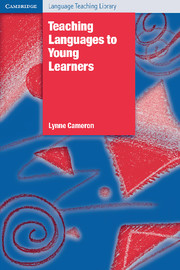Book contents
- Frontmatter
- Contents
- Preface
- Acknowledgements
- 1 Children learning a foreign language
- 2 Learning language through tasks and activities
- 3 Learning the spoken language
- 4 Learning words
- 5 Learning grammar
- 6 Learning literacy skills
- 7 Learning through stories
- 8 Theme-based teaching and learning
- 9 Language choice and language learning
- 10 Assessment and language learning
- 11 Issues around teaching children a foreign language
- References
- Index
2 - Learning language through tasks and activities
Published online by Cambridge University Press: 05 May 2010
- Frontmatter
- Contents
- Preface
- Acknowledgements
- 1 Children learning a foreign language
- 2 Learning language through tasks and activities
- 3 Learning the spoken language
- 4 Learning words
- 5 Learning grammar
- 6 Learning literacy skills
- 7 Learning through stories
- 8 Theme-based teaching and learning
- 9 Language choice and language learning
- 10 Assessment and language learning
- 11 Issues around teaching children a foreign language
- References
- Index
Summary
The task as an environment for learning
In this chapter I set up a framework for analysing tasks from a learning perspective that takes account of young learners' social and cognitive development. Classroom tasks and activities are seen as the ‘environment’ or ‘ecosystem’ (van Geert 1995) in which the growth of skills in the foreign language takes place. The idea of ‘task’ will need to be adapted slightly from the way it is used in current ‘task-based’ approaches to language teaching, and will be given a (post-)Vygotskyan slant.
Our starting point in this chapter is children as (mentally) active learners, who will try to find a meaning and purpose for activities that are presented to them. Young learners work hard to make sense of what teachers ask them to do, and come to tasks with their own understandings of the purposes and expectations of adults. Studies of young children starting school have shown how much difference there often is between language use and activities at home and at school, but also how quickly children work out what is expected of them and how to fit into the new patterns of interaction (e.g. Tizard and Hughes 1984). We can predict that children will bring these abilities to their language lessons, and that this urge to find meaning and purpose can be a very helpful language learning tool for teachers to exploit. Unfortunately, even the most motivated child can have problems making sense of some of the activities in which they are asked to participate in their language lessons; the combined effect of the activity-type and new language can render everything just too mysterious.
- Type
- Chapter
- Information
- Teaching Languages to Young Learners , pp. 21 - 35Publisher: Cambridge University PressPrint publication year: 2001

